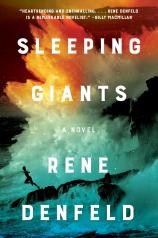Sleeping Giants
Review
Sleeping Giants
A nine-year-old boy running into the stormy ocean. A young woman looking for her lost brother and struggling to negotiate the world with a brain that can’t handle numbers. A bereaved ex-cop learning to live on his own. A polar bear who’s sadder and more solitary than others of her kind. In SLEEPING GIANTS, Rene Denfeld’s latest mystery, all the characters are wounded, both the victims and those who try to help them.
Denfeld began exploring these themes in THE CHILD FINDER (2017) and its sequel, THE BUTTERFLY GIRL (2019). In the first, private investigator Naomi Cottle, whose superpower is finding lost children, searches for a little girl who disappeared in the Oregon woods; in the second, Cottle delves into her own fragmented past, pursuing a vanished younger sister who plagues her dreams. SLEEPING GIANTS, like these earlier books, is set in the Pacific Northwest, where Denfeld lives, and its rugged beaches and haunted forests provide a fitting background for her emotionally fraught stories.
"SLEEPING GIANTS is a hybrid: a passionate cry for the protection and understanding of the most vulnerable among us, and an absorbing detective story."
The key mystery here concerns a boy, Dennis Owens, presumed drowned 20 years ago in an obscure beach town called Eagle Cove. He had escaped from Brightwood, a local center for troubled kids, but what happened to make him run away? His sister, Amanda Dufresne, wants answers. Although she is smart, compassionate and good with animals --- she works at a zoo --- she has a math learning disability as well as severe social anxiety, and her adoptive parents are inclined to be overprotective. When her search brings her to Eagle Cove, it is the first step in a coming-of-age tale of sorts, her bid for greater autonomy and happiness.
A local fisherman has carved a memorial to Dennis, and it is there that Amanda encounters Larry Palmer, a retired cop. It was his wife’s idea to move to this remote beach community, but now she’s dead and Larry finds himself grumpy, bored and desperately lonely. Meeting Amanda, forming an informal investigative team, makes him feel human again for the first time in months.
The novel unfolds in chapters that alternate between a contemporary narrative --- Larry and Amanda’s search for the truth --- and Dennis’ life at Brightwood two decades earlier. Little by little, the two detectives build a picture of the “home,” more like a prison, where the boy spent his days. They quiz local sources (the cook; the Eagle Cove constable; another resident, now grown) and draw on a couple of helpful contacts from Larry’s past as a police officer, but, ironically, child-protection laws mean that information about Dennis is hard to come by.
At the same time, the reader learns about the daily reality of Brightwood in chapters narrated by Dennis and by Ralph, the custodian who befriends him. When a new director, Martha King, arrives, determined to “cure” the most difficult boys with a method known as “holding time,” the real crisis begins. She presents her treatments as a form of love. They’re more like torture. It turns out that before Brightwood, she was the director of a similar institution in Arizona. There, huge, mysterious human-shaped designs millions of years old --- known as “sleeping giants” --- are etched into the southwestern desert. Their hollow bodies and raised arms suggest lost souls: possibly the boys at the center, or perhaps Martha herself, with her creepy family background.
There is a touching secondary plot line involving Molly, Amanda’s polar bear charge at the zoo. Found by Arctic researchers in an empty den when she was a cub and now 15 years old, Molly has never been in a setting where she learned how to get along with other bears, so she is an unhappy outsider, though deeply attached to Amanda. There’s an obvious parallel being drawn here between Molly and kids like Dennis, who lacked social skills because he’d lived in foster homes or group homes since early childhood.
Yet none of Denfeld’s characters feel like pitiable case studies. Despite being complicated, fragile and sometimes hard to love, they are wonderfully brave and spirited. You hope that Amanda can unearth her brother’s history and come to terms with her own distinctive brain. You yearn for Larry to drop his curmudgeonly cop persona and let other people in. You root for the Brightwood residents not to give up on life. (One caveat: I wish Denfeld didn’t switch points of view so frequently. It interferes with a clear narrative line and dilutes the suspense.)
SLEEPING GIANTS does occasionally slip into being more of a “message” novel than a thriller. Holding time was once a popular form of therapy, though now it is largely condemned. Denfeld herself, who adopted three kids from the foster system (and wrote about it for the New York Times in a “Modern Love” essay in 2017), was advised to try it on one of her sons. Her horror at what it entailed and its consequences (trauma, even death) presumably led directly to this book.
SLEEPING GIANTS is a hybrid: a passionate cry for the protection and understanding of the most vulnerable among us, and an absorbing detective story. The mix makes a weird sort of sense, because each angry, disconnected individual, child or adult (or bear!), can be seen as a puzzle. To solve it, you need to use not simply your intellect but your heart. You need to look beyond superficial clues for the underlying motives, the texture of experience, the emotional truth. And isn’t that the definition of a great mystery?
Reviewed by Katherine B. Weissman on March 29, 2024




